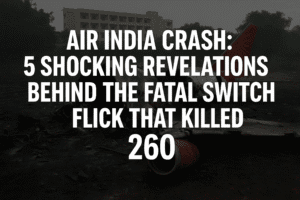Air India Crash: 5 Shocking Revelations Behind the Fatal Switch Flick That Killed 260
India’s investigation into the June 12th Air India crash that killed 260 people reveals a critical focus on the pilots’ final moments. Preliminary data confirms both engine fuel switches were moved to “cutoff” seconds after takeoff from Ahmedabad, starving the Boeing 787 of power.
Cockpit recordings capture the First Officer questioning Captain Sumeet Sabharwal about moving the switches, with Sabharwal reportedly denying doing so. Experts note the First Officer, actively flying, was unlikely to manipulate overhead controls at that critical phase.
Despite switches being reset, the jet—too low and slow—crashed after losing thrust. While no mechanical faults were found, the investigation now intensely scrutinizes human factors: potential error, intent, crew dynamics, and the profound weight of responsibility behind a single, fatal action. The final report must unravel why those switches moved.

Air India Crash: 5 Shocking Revelations Behind the Fatal Switch Flick That Killed 260
The charred wreckage of Air India flight AI-301, bound for London Gatwick, remains a stark monument in Ahmedabad. The June 12th crash, claiming 260 lives, sent shockwaves globally. While India’s preliminary investigation report, released Saturday, found no mechanical or maintenance faults, a chilling narrative is emerging, centering on the final moments in the cockpit and the flick of two switches.
The Critical Seconds After Liftoff:
According to the report by India’s Aircraft Accident Investigation Bureau (AAIB) and subsequent reporting by the Wall Street Journal citing sources familiar with the U.S. assessment, the sequence of events was tragically swift:
- Liftoff: The Boeing 787 Dreamliner, piloted by First Officer Clive Kunder (3,403 flying hours) with Captain Sumeet Sabharwal (15,638 hours) monitoring, departed Ahmedabad.
- The Switch Movement: Just seconds after becoming airborne, the fuel control switches for both engines were moved from “RUN” to “CUTOFF” – one second apart.
- The Question in the Cockpit: The cockpit voice recorder (CVR) captured First Officer Kunder asking Captain Sabharwal why he had moved the fuel switches. The Captain reportedly responded that he had not done so.
- Power Loss: Almost immediately, the deployment of the Ram Air Turbine (RAT), an emergency backup power source, was captured on CCTV, confirming a catastrophic loss of main engine power.
- Desperate Attempt: The fuel switches were reportedly moved back to “RUN,” triggering an automatic engine restart sequence.
- Unrecoverable: Aviation safety expert John Nance explained the grim reality: the aircraft, at only 650 feet, was too low and too slow. It lost thrust, began sinking, clipped obstacles, and crashed into a medical college building in a fireball.
The Central Mystery: Intent or Incident?
The preliminary report meticulously avoids assigning blame or confirming who moved the switches. It simply documents the physical switch movement and the verbal exchange. However, the implications are profound:
- The Captain’s Denial: Sabharwal’s reported denial, captured on the CVR, stands in stark contrast to the physical evidence of the switch movement.
- The First Officer’s Hands: As reported by the WSJ and echoed by U.S. pilots reviewing the report, Kunder, as the pilot flying during the critical takeoff phase, would have been intensely focused on the controls, making it unlikely he manipulated the overhead fuel switches at that precise moment.
- “No Other Rational Explanation”: John Nance stated the accumulating circumstantial evidence points towards a crew member flipping the switches, emphasizing no other explanation consistent with the data has emerged.
Beyond the Switches: The Human and Systemic Context
While the fuel switch movement is the focal point, the investigation is far from over. As Nance stresses, crashes are rarely caused by a single factor. Investigators must now delve deeper:
- Pilot State: What was the mental and physical state of both pilots? Were there underlying medical issues, fatigue, or undisclosed stressors?
- Crew Dynamics: What was the working relationship between Sabharwal and Kunder? Was there miscommunication, confusion, or conflict?
- Training and Procedures: Were procedures for monitoring switch positions and handling emergencies during takeoff adequately followed or ingrained?
- Cockpit Cameras: The tragedy has reignited the contentious debate about installing cockpit image recorders. Nance believes video evidence could have been crucial here, providing undeniable clarity on actions within the flight deck, though privacy concerns remain significant.
- Air India’s Oversight: The crash occurs amidst heightened scrutiny of Air India’s safety culture, particularly at its budget subsidiary Air India Express, which faces an EU probe over alleged falsification of maintenance records on Airbus jets.
Boeing’s Response and the Path Forward
Significantly, the AAIB report contained no safety recommendations for Boeing or engine maker GE. Following its release, the FAA and Boeing reportedly privately affirmed the safety of the existing fuel switch lock mechanisms, suggesting they don’t believe a design flaw contributed. The focus remains squarely on human factors and operational procedures.
The Unbearable Weight of Truth
For the families of the 241 passengers and crew lost onboard, and the 19 victims on the ground, the emerging details offer no solace, only a more painful picture of the final moments. The investigation’s shift towards potential crew actions adds a layer of profound human tragedy to the mechanical facts.
The AAIB’s final report, due within a year, carries an immense burden. It must not only determine the physical sequence of events but also unravel the complex human elements – the pressures, the potential errors, the split-second decisions – that converged with such devastating consequences. The truth, however difficult, is essential not just for justice, but for preventing history from repeating itself. The flick of those two switches has left an indelible scar, and understanding why it happened is the world’s most solemn duty to the victims.
You must be logged in to post a comment.